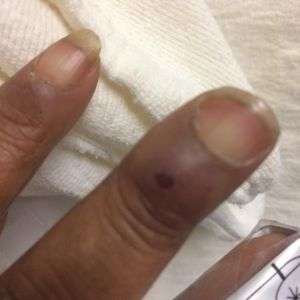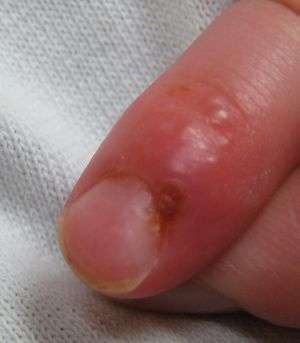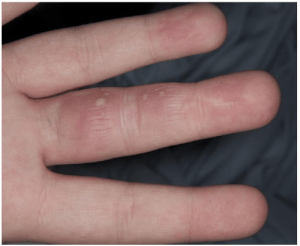Herpetic whitlow
Background
- HSV infection of distal finger[1]
- Usually occurs from contact with oral herpes, or autoinoculation from genital herpes
- Incubation period of 2-20 days, with possible prodrome of fever or malaise
- 60% due to HSV-1, 40% due to HSV-2

Whitlow
Clinical Features

Herpetic whitlow

Herpetic whitlow with erythema and vesicles.
- Same burning, pruritic sensation as from other herpes infections
- Vesicular ullae
- Finger may be indurated and tender (but should not be tense, as in a felon)
- Rash develops over 7-10 days, with possible ulceration and rupture
- Symptoms improve, crust over, and heal after 10-14 days with viral shedding terminating at this point
- Complete resolution by 15-21 days
Differential Diagnosis
Evaluation
- Clinical diagnosis, based on history and physical exam
- Available laboratory studies (not required for diagnosis)[2]:
- Viral culture (gold standard)
- Direct immunofluorescence
- Tzanck smear (poor specificity)
Management
- Immobilization, elevation, analgesia
Antivirals
Antivirals such as Acyclovir or Valacyclovir may shorten duration of infection[3]
Secondary Prevention
- Application of clean dressings to involved digits is important to prevent autoinoculation or spread to other individuals
Disposition
- Outpatient managment
See Also
References
- Wu IB, Schwartz RA. Herpetic whitlow. Cutis. Mar 2007;79(3):193-6
- Mohan RPS, Verma S, Singh U, Agarwal N. Acute primary herpetic gingivostomatitis. BMJ Case Reports. 2013;2013:bcr2013200074. doi:10.1136/bcr-2013-200074.
- Nikkels AF, Pierard GE. Treatment of mucocutaneous presentations of herpes simplex virus infections. Am J Clin Dermatol. 2002;3(7):475-87.
This article is issued from
Wikem.
The text is licensed under Creative
Commons - Attribution - Sharealike.
Additional terms may apply for the media files.